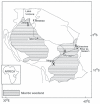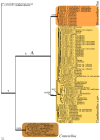Afrocantharellus gen. stat. nov. is part of a rich diversity of African Cantharellaceae
- PMID: 23155498
- PMCID: PMC3399100
- DOI: 10.5598/imafungus.2012.03.01.04
Afrocantharellus gen. stat. nov. is part of a rich diversity of African Cantharellaceae
Abstract
A new genus in the Cantharellaceae, Afrocantharellus, is recognized based on results from phylogenetic analyses of rDNA LSU and concatenated LSU/5.8-ITS2/ATP6 data. It was previously recognized as a subgenus, but comprehensive fieldwork and the acquisition of numerous sequences for previously neglected African Cantharellus species formed the basis for a reappraisal of generic and species delimitations. Afrocantharellus is characterized morphologically by the basidiomes having thick, distantly spaced diverging folds of variegated colour. In contrast to most of Cantharellus, Afrocantharellus mostly lacks clamp connections. Phylogenies of Cantharellus and Afrocantharellus based on LSU and a concatenated data set are provided, along with descriptions of and a key to the four species and one form of Afrocantharellus recognized. Six new combinations are made.
Keywords: ATP6; Africa; Cantharellus; ITS; LSU; Molecular phylogeny; Tanzania.
Figures




Similar articles
-
Cantharellus violaceovinosus, a new species from tropical Quercus forests in eastern Mexico.MycoKeys. 2018 Mar 20;(32):91-109. doi: 10.3897/mycokeys.32.22838. eCollection 2018. MycoKeys. 2018. PMID: 29681739 Free PMC article.
-
Updated taxonomy of Chinese Cantharellus subgenera Afrocantharellus and Magni (Hydnaceae, Cantharellales): Three new taxa and amended descriptions of one previous species.Front Microbiol. 2023 Mar 17;14:1109831. doi: 10.3389/fmicb.2023.1109831. eCollection 2023. Front Microbiol. 2023. PMID: 37007503 Free PMC article.
-
New records of Cantharellus species from the northwestern Himalayas of India.Mycology. 2013 Dec;4(4):205-220. doi: 10.1080/21501203.2013.872205. Epub 2014 Jan 2. Mycology. 2013. PMID: 24587961 Free PMC article.
-
Cantharellaceae of Guyana II: new species of Craterellus, new South American distribution records for Cantharellus guyanensis and Craterellus excelsus, and a key to the Neotropical taxa.Mycologia. 2014 Mar-Apr;106(2):307-24. doi: 10.3852/106.2.307. Mycologia. 2014. PMID: 24782498
-
Cantharellaceae of Guyana I: new species, combinations and distribution records of Craterellus and a synopsis of known taxa.Mycologia. 2012 Nov-Dec;104(6):1466-77. doi: 10.3852/11-412. Epub 2012 Jun 8. Mycologia. 2012. PMID: 22684285
Cited by
-
Cantharellus violaceovinosus, a new species from tropical Quercus forests in eastern Mexico.MycoKeys. 2018 Mar 20;(32):91-109. doi: 10.3897/mycokeys.32.22838. eCollection 2018. MycoKeys. 2018. PMID: 29681739 Free PMC article.
-
Wild Foods Are Positively Associated with Diet Diversity and Child Growth in a Protected Forest Area of Madagascar.Curr Dev Nutr. 2024 Feb 13;8(4):102101. doi: 10.1016/j.cdnut.2024.102101. eCollection 2024 Apr. Curr Dev Nutr. 2024. PMID: 38590953 Free PMC article.
-
Updated taxonomy of Chinese Cantharellus subgenera Afrocantharellus and Magni (Hydnaceae, Cantharellales): Three new taxa and amended descriptions of one previous species.Front Microbiol. 2023 Mar 17;14:1109831. doi: 10.3389/fmicb.2023.1109831. eCollection 2023. Front Microbiol. 2023. PMID: 37007503 Free PMC article.
-
Wild mushroom--an underutilized healthy food resource and income generator: experience from Tanzania rural areas.J Ethnobiol Ethnomed. 2013 Jul 10;9:49. doi: 10.1186/1746-4269-9-49. J Ethnobiol Ethnomed. 2013. PMID: 23841964 Free PMC article.
-
A Contribution to Knowledge of Craterellus (Hydnaceae, Cantharellales) in China: Three New Taxa and Amended Descriptions of Two Previous Species.Front Microbiol. 2022 Jul 13;13:906296. doi: 10.3389/fmicb.2022.906296. eCollection 2022. Front Microbiol. 2022. PMID: 35903463 Free PMC article.
References
-
- Bas C. (1969) Morphology and subdivision of Amanita and amonograph on its section Lepidella. Persoonia 5: 285–579
-
- Binder M, Hibbett DS. (2002) Higher-level phylogenetic relationships of Homobasidiomycetes (mushroom-forming fungi) inferred from four rDNA regions. Molecular Phylogenetics and Evolution 22: 76–90 - PubMed
-
- Binder M, Hibbett DS, Larsson KH, Larsson E, Langer E, Langer G. (2005) The phylogenetic distribution of resupinate forms across the major clades of mushroom-forming fungi (Homobasidiomycetes). Systematics and Biodiversity 3: 113–157
-
- Buyck B. (1994) Ubwoba: Les Champignons Comestibles de l’Ouest du Burundi. [Publicacion Agricole no. 34.] Bruxelles: Administration Generale de la Cooperation au Developpement;
-
- Buyck B, Nzigidahera B. (1995) Ethnomycological notes from western Burundi. Belgian Journal of Botany 128: 131–138
LinkOut - more resources
Full Text Sources
Molecular Biology Databases
